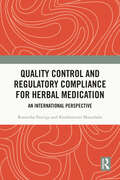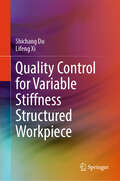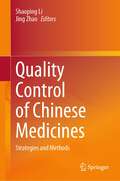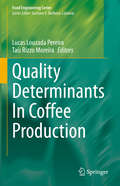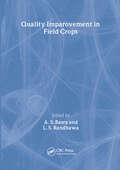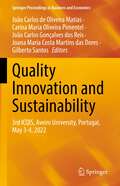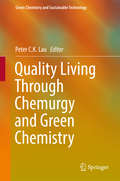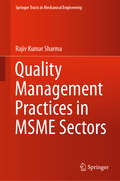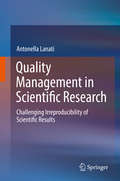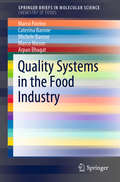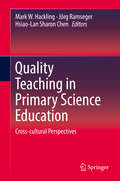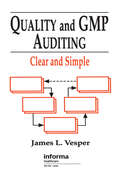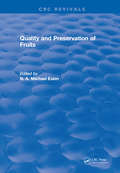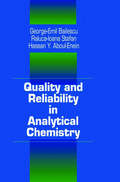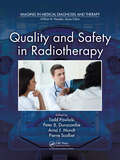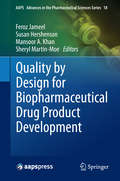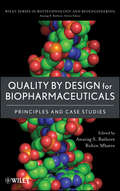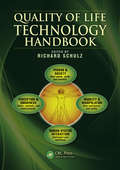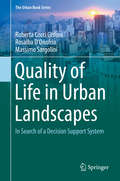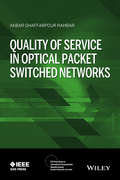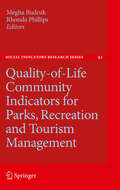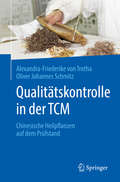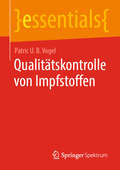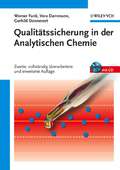- Table View
- List View
Quality Control and Regulatory Compliance for Herbal Medication: An International Perspective
by Krishnaveni Manubolu Raveesha PeerigaThis comprehensive book provides a detailed framework for the evaluation and standardization of herbal products, promoting the safe and effective use of herbal medicines through rigorous testing and compliance with global regulatory requirements.It begins with an overview of the fundamental tests for medicinal plant materials, followed by an in-depth look at World Health Organization (WHO) guidelines for quality control and the evaluation of commercial drugs. The book explores quality assurance practices like cGMP, GAP, GMP and GLP with a focus on traditional medicine systems, while also examining EU and ICH guidelines, stability testing and the application of chromatographic techniques in product standardization. Additionally, it addresses the preparation of documents for new drug applications, export registration and regulatory requirements, as well as providing guidelines on Pharmacovigilance and comparisons between various herbal pharmacopoeias.A valuable reference work for professionals in the pharmaceutical industries as well as researchers and students interested in this topic.
Quality Control for Variable Stiffness Structured Workpiece
by Shichang Du Lifeng XiThis book investigates quality control methods for variable stiffness structured workpiece. With the development of modern manufacturing industries, more and more workpieces with complex geometries are being designed and manufactured. The definition of variable stiffness structured workpieces includes three key features: multiple geometrical features, multiple geometrical tolerance constraints, and multistage manufacturing processes (denoted as 3M features). The variable stiffness structured workpieces have multiple geometrical features (planar surfaces, cylindrical surfaces, cone surfaces, sphere surfaces, freeform surfaces, etc.) with multiple geometric tolerance constraints (flatness, waviness, roughness, roundness, cylindrical degree, etc.) and are manufactured by multiple manufacturing processes. The 3M features of variable stiffness structured workpieces bring challenges for products&’ quality evaluation and quality control. The quality propagation of multiple quality characteristics through multiple manufacturing processes is complicated. The multiscale geometrical specifications influence the final functions of products in different ways. And the varied stiffness problem brought by complex geometry structure of the workpieces also makes the manufactured surface quality hard to control. The book is intended for undergraduate, graduate students, and researchers who are interested in developments of quality control methods and applications.
Quality Control of Chinese Medicines: Strategies and Methods
by Jing Zhao Shaoping LiThis book focuses on the strategies and methods for quality control of Chinese medicines used in prevention and treatment of diseases for thousands of years in China and East Asia. It explains various strategies and methods for quality markers discovery and herbal glycoanalysis, as well as practices for control of heavy metal and pesticide residues. Strategies to overcome the shortage of reference compounds for quality control of Chinese medicines are also provided. The book also introduces analytical techniques for different analytes in Chinese medicines with an emphasis on sample preparation in automation and high extraction efficiency methods, the key process affecting the time and accuracy of the techniques. It is of interest to quality control scientists in academia and industry working on Chinese medicines and/or herbal medicine and also pharmacists, pharmacologists, food chemists, and nutritionists who want to understand Chinese medicines.
Quality Determinants In Coffee Production (Food Engineering Series)
by Lucas Louzada Pereira Taís Rizzo MoreiraQuality Determinants In Coffee Production presents a comprehensive overview of the main determinants of coffee quality during processing. Authored by members of the Laboratory for Analysis and Research in Coffee at the Federal Institute of Espírito Santo, the chapters in this text explain how coffee quality can be affected through each step of the main processing methods. The first section explores the history of coffee processing, covering how the processes and techniques of sensorial analysis have developed. The second section covers the evolution of these techniques and how various complexities can affect their use, plus the statistical tools that are used to increase test accuracy. Another section focuses on the relationship between fruit microbiology and coffee quality, promoting an understanding of how yeasts, fungi and bacteria effect the quality of coffee during processing. Another section is dedicated to the biotechnological processes used in coffee production, including the applicability of induced and spontaneous routes from the manipulation of raw material, the relationship between wet processing and spontaneous fermentation and the construction of sensorial routes. A final section explores volatile coffee compounds and gas chromatography techniques, including chemical and sensory maps. The majority of the reference works published on coffee processing have a pragmatic approach covering production, harvesting, post-harvesting and marketing. This work goes beyond these subjects, covering the factors that impact quality and how they lead to either qualitative reduction or gains during processing. New technological and scientific indicators for the modification and the creation of sensory routes are extensively covered, as are the international protocols used in the sensorial analysis of coffee. With its broad approach, this text presents a multidisciplinary perspective connecting areas such as statistics, biochemistry, analytical chemistry and microbiology to the results of sensory analysis using different technologies and processes. A direct relationship between these factors is established in order to help researchers understand their combined effect on coffee quality during processing.
Quality Improvement in Field Crops
by Lakhwinder S RandhawaLearn to identify, modify, and manipulate the genes controlling key quality traits in field crops!This informative book provides state-of-the-art information on improving nutritional quality as well as yield volume in field crops such as wheat, maize, rice, barley, oats, lentils, pigeon peas, soybeans, cool season legumes, and crops whose seeds are used to make oils. With contributions from leading authorities in the field, this book will bring you up to date on the uses of agronomic management, conventional plant breeding, and modern biotechnologies in improving the quality of important food, feed, and fiber products.Quality Improvement in Field Crops examines: factors that impact the end-use quality of wheat and ways to improve wheat’s quality for milling and baking agronomic practices that impact the quality of maize ways to improve the nutritional value of rice and legumes techniques for using molecular markers to improve the quality of lentil crops breeding methods that can improve the quality of the oils derived from oilseed crops protein quality/sulfur metabolism in soybeans and much more!This book is dedicated to the World Food Laureate (the equivalent of the Nobel Prize for food scientists), Dr. G. S. Khush--the father of the Green Revolution in rice farming--in recognition of his tremendous contributions to global food and nutritional security for the world?s population.
Quality Innovation and Sustainability: 3rd ICQIS, Aveiro University, Portugal, May 3-4, 2022 (Springer Proceedings in Business and Economics)
by Gilberto Santos João Carlos Gonçalves dos Reis Joana Maria Costa Martins das Dores João Carlos de Oliveira Matias Carina Maria Oliveira PimentelThis book provides various approaches to complex industrial problems in sustainability, operations management and industrial engineering. It features in-depth research presented by academics, scholars, researcher and professionals at the 3rd International Conference on Quality Innovation and Sustainability (ICQIS) in the fields of quality, innovation, sustainability and operations management. It addresses topics such as quality management systems; Lean and Six Sigma; information systems for quality management; data management and industry 4.0; innovative solutions for quality challenges; environmental quality policies and standards; circular economy and life cycle costing; occupational health; safety and welfare in manufacturing; and smart systems, among others.
Quality Labs for Small Brewers: Building a Foundation for Great Beer
by Merritt WaldronQuality assurance and quality control (QA/QC) is both a system and a state of mind. In Quality Labs for Small Brewers, author Merritt Waldron walks you step-by-step through the process of establishing and writing a quality program for your brewery. Your quality policy should align with your company values and inculcate a quality-first culture throughout your brewery. Building an effective quality program will empower staff to directly influence the consistent production of safe, quality beer from grain to glass.A good quality program has many moving parts but it is underpinned by good manufacturing practice (GMP) and food safety requirements. GMP covers every aspect of a brewery's operation, not just how personnel comport themselves, but how goods in are handled and stored, how beer is held in the warehouse, and how equipment, plant, and the grounds are maintained. Learn how to set standards and critical control points, and how to effectively monitor your process so that any deviation is quickly addressed.Discover how policies, procedures, and specifications can help ensure quality throughout every process. Involve your staff in establishing standard operating procedures, corrective actions, and improvements. Learn how to effectively delegate responsibility and also ensure that management is armed with the information they need to ultimately make what may be some tough decisions. If the worst happens, understand that being able to make a tough call and having a robust recall procedure in place means you can move quickly to rectify matters, which helps your brewery retain the confidence of your customers and distributors.Brewers will see results through the application of GMP and food safety prerequisite programs. Your quality manual laying out standard operating procedures, product specifications, and corrective action plans will give your staff the confidence to implement your quality program. With these programs in place, the author then takes you through each area of your brewery operation and breaks down how key parameters are measured and analyzed at critical control points. Sampling plans are outlined for monitoring density, temperature, pH, yeast viability and growth, alcohol, carbonation, dissolved oxygen, titratable acidity, fill height, and packaging integrity. Explore setting up an effective sensory panel, even a small one, that will help ensure each beer remains true-to-brand. Waldron outlines building your brewery laboratory and looks at how to implement an in-house microbiology program. Throughout this, the focus is on scaling your efforts to the size of your operation and always being ready to expand your quality program as your brewery grows. The author makes it clear that no brewery is too small to implement QA/QC and discusses pragmatic solutions to building out your capabilities.Beyond taking meaningful, accurate measurements, the author also explores how to analyze data. Learn some basics of statistics and data organization and how to apply these techniques to continuously monitor processes and spot when corrective action is needed. These routines will help pinpoint any risks or areas of improvement and ensure that only quality beer reaches the customer, time after time.
Quality Living Through Chemurgy and Green Chemistry
by Peter C.K. LauThis book is intended to give readers an appreciation of what the future holds, as cutting-edge technologies in synthetic biology and pathway engineering and advanced bioprocessing development pave the way for providing goods and services to benefit humankind that are based on the synergy of two biomasses - i. e. of what a renewable feedstock could yield and an infinite microbial biomass could provide in terms of enzymes and biocatalysts. This 13-chapter book, with an introductory treatise on the guiding principles of green chemistry and engineering metrics, brings together a broad range of research and innovation agendas and perspectives from industries, academia and government laboratories using renewable feedstocks that include macroalgae and lignins. In addition, social-economic aspects and the pillars of competitiveness in regional cluster development are explored as we transition from fossil-fuel-based economies to a circular bioeconomy, with chemurgy and green chemistry being implicit to the innovation movement. The bulk of the book covers specific applications including the bioproduction of amino sugars, dicarboxylic acids, omega-3 fatty acids, starch and fermentable sugars from lignocellulosic materials, and phenolics as building blocks for polymer synthesis. Enzymatic systems for accessing chiral and special-purpose chemicals, as well as the development of specialized enzymes from macroalgae for biofuel and biochemical production are also addressed. Research gaps, hurdles to overcome in various biological processes, and present achievements in the production of biofuels and biochemicals from lignocellulosic materials are discussed. Going beyond the conventional expectation of discussing the production of drop-in chemicals, the book instead emphasizes how the potential of new chemicals and materials can be harnessed through innovative thinking and research. As such, it provides an invaluable reference source for researchers and graduate students interested in Chemurgy and Green Chemistry, as well as for practitioners in the field of industrial biotechnology and biobased industry. Peter C. K. Lau is a Distinguished Professor at Tianjin Institute of Industrial Biotechnology of the Chinese Academy of Sciences, and an Adjunct Professor at the Departments of Chemistry and Microbiology & Immunology, McGill University, Canada.
Quality Management Practices in MSME Sectors (Springer Tracts in Mechanical Engineering)
by Rajiv Kumar SharmaThe book explains the importance of and investigates the quality management aspects in micro, small and medium enterprises (MSME) sectors. It emphasizes on the need of quality management practice and explores the applicability of various quality tools in MSMEs and stages in company where quality management practices are applied. Various topics covered in this book include control charts, Pareto charts, customer relationship management, failure mode effect analysis, QMS implementation stages, competitiveness, and benefits of QM practices. This book will be useful for the researchers and industry professionals from the areas of mechanical engineering, industrial engineering, and manufacturing.
Quality Management in Scientific Research: Challenging Irreproducibility Of Scientific Results
by Antonella LanatiIn recent years, the attention of the scientific and social community has not solely been on producing new findings, but increasingly also on the related issues of the reliability, safety, and efficacy of the discoveries made, as well as the efficient and effective use of resources. The adoption of management models and tools can help scientists to improve their research, ensuring valuable, robust and dependable outcomes. Quality disciplines have been widely used for decades in industrial and business fields, building a knowledge base that can be translated and exploited, much to the advantage of scientific research. However, quality references in scientific research are still extremely rare and largely limited to an international guideline and a few sector-specific standards. Despite WHO and EU Commission campaigns, there are still precious few practical texts that offer researchers guidance on quality principles and provide simple tools and methodologies for their daily work. The book, starting from the problem of the reproducibility of scientific results and the substantial contribution that the Quality approach can make to research (Chapter 1), introduces the reader to key principles and basic concepts of Quality and illustrates both general and research-specific quality standards, paving the way for further discussion (Chapter 2). In turn, Chapter 3 presents detailed applications of Quality principles in various aspects of research, from study and ethics to materials and equipment management. Chapters 4 and 5, respectively, are devoted to Quality tools and Quality methodologies, as well as soft skills, all of which are valuable to scientific experimentation and study management. The concepts and practical tools discussed are extensively illustrated with examples from actual applications in scientific research.
Quality Systems in the Food Industry (SpringerBriefs in Molecular Science)
by Arpan Bhagat Marco Fiorino Caterina Barone Michele Barone Marco MasonThis book explains the role of food-oriented (or ‘food-centric’) quality system standards in the modern food and beverage industry. It discusses food safety schemes based on the international norm ISO 9001 and the “Hazard Analysis and Critical Control Points” approach, and also introduces the new Global Standard for Food Safety (GSFS) and the International Featured Standard (IFS, 7th ed.), outlining standardization for international equivalence (while maintaining the necessary flexibility and independence – which is not always easy an easy task).Providing selected specific examples, it examines the problems of chemical additives and possible cross-contaminations between different production lines, as well as adequate reactions to and handling of intentional adulterations. In addition, it includes a chapter focusing on quality audits and technical data sheets in the food industry, and a final chapter describing the certification of food-grade lubricants in the food industry, especially with regard to allergenic substances.
Quality Teaching in Primary Science Education
by Mark W. Hackling Jörg Ramseger Hsiao-Lan Sharon ChenThis edited volume explores how primary school teachers create rich opportunities for science learning, higher order thinking and reasoning, and how the teaching of science in Australia, Germany and Taiwan is culturally framed. It draws from the international and cross-cultural science education study EQUALPRIME: Exploring quality primary education in different cultures: A cross-national study of teaching and learning in primary science classrooms. Video cases of Year 4 science teaching were gathered by research teams based at Edith Cowan University, Deakin University, the Freie Universit#65533;t Berlin, the National Taiwan Normal University and the National Taipei University of Education. Meetings of these research teams over a five year period at which data were shared, analysed and interpreted have revealed significant new insights into the social and cultural framing of primary science teaching, the complexities of conducting cross-cultural video-based research studies, and the strategies and semiotic resources employed by teachers to engage students in reasoning and meaning making. The book's purpose is to disseminate the new insights into quality science teaching and how it is framed in different cultures; methodological advancements in the field of video-based classroom research in cross-cultural settings; and, implications for practice, teacher education and research. "The chapters (of this book) address issues of contemporary relevance and theoretical significance: embodiment, discursive moves, the social unit of learning and instruction, inquiry, and reasoning through representations. Through all of these, the EQUALPRIME team manages to connect the multiple cultural perspectives that characterise this research study. The 'meta-reflection' chapters offer a different form of connection, linking cultural and theoretical perspectives on reasoning, quality teaching and video-based research methodologies. The final two chapters offer connective links to implications for practice in teacher education and in cross-cultural comparative research into teaching and learning. These multiple and extensive connections constitute one of the books most significant accomplishments. The EQUALPRIME project, as reported in this book, provides an important empirical base that must be considered by any system seeking to promote sophisticated science learning and instructional practices in primary school classrooms. By exploring the classroom realisation of aspirational science pedagogies, the EQUALPRIME project also speaks to those involved in teacher education and to teachers. I commend this book to the reader. It offers important insights, together with a model of effective, collegial, collaborative inter-cultural research. It will help us to move forward in important ways". Professor David Clarke, Melbourne University
Quality and GMP Auditing: Clear and Simple
by James L. VesperThis guidebook provides proven methods and techniques for performing effective audits that serve your department, your company, and you. Topics covered relate to the four key competencies essential for successful GMP audits. Includes the rationale for auditing as an important quality tool, along with the audit cycle, broken into five distinct phase
Quality and Preservation of Fruits
by N. A. EskinThis book discusses the agronomic factors affecting the quality of major fruits grown in North America, as well as the storage and processing of these crops. Quality factors discussed include appearance, texture, flavor, and nutritional quality. Fruits covered include oranges, grapefruit, lemons, grapes, apples, peaches, nectarines, plums, strawberries, pears, and cherries. Quality and Preservation of Fruits is a detailed reference resource for researchers and teachers in horticulture and food science.
Quality and Reliability in Analytical Chemistry (Analytical Chemistry)
by Hassan Y. Aboul-Enein Raluca-Ioana Stefan George E. BaiulescuQuality and reliability are central to success in every discipline, but perhaps nowhere are they more important or more interconnected than in the practice of analytical chemistry. Here, although reliable analytical information implies quality, not all "quality" information proves reliable.Quality and Reliability in Analytical Chemistry examine
Quality and Safety in Radiotherapy (Imaging in Medical Diagnosis and Therapy)
by Todd Pawlicki Pierre Scalliet Peter B. Dunscombe Arno J. MundtThe first text to focus solely on quality and safety in radiotherapy, this work encompasses not only traditional, more technically oriented, quality assurance activities, but also general approaches of quality and safety. It includes contributions from experts both inside and outside the field to present a global view. The task of assuring quality
Quality by Design for Biopharmaceutical Drug Product Development
by Feroz Jameel Susan Hershenson Mansoor A. Khan Sheryl Martin-MoeThis volume explores the application of Quality by Design (QbD) to biopharmaceutical drug product development. Twenty-eight comprehensive chapters cover dosage forms, liquid and lyophilized drug products. The introductory chapters of this book define key elements of QbD and examine how these elements are integrated into drug product development. These chapters also discuss lessons learned from the FDA Office of Biotechnology Products pilot program. Following chapters demonstrate how QbD is used for formulation development ranging from screening of formulations to developability assessment to development of lyophilized and liquid formats. The next few chapters study the use of small-scale and surrogate models as well as QbD application to drug product processes such as drug substance freezing and thawing, mixing, sterile filtration, filling, lyophilization, inspection and shipping and handling. Later chapters describe more specialized applications of QbD in the drug product realm. This includes the use of QbD in primary containers, devices and combination product development. The volume also explores QbD applied to vaccine development, automation, mathematical modeling and monitoring, and controlling processes and defining control strategies. It concludes with a discussion on the application of QbD to drug product technology transfer as well as overall regulatory considerations and lifecycle management. Quality by Design for Biopharmaceutical Drug Product Development is an authoritative resource for scientists and researchers interested in expanding their knowledge on QbD principles and uses in creating better drugs.
Quality by Design for Biopharmaceuticals: Principles and Case Studies (Wiley Series in Biotechnology and Bioengineering #1)
by Anurag S. Rathore Rohin MhatreThe concepts, applications, and practical issues of Quality by Design Quality by Design (QbD) is a new framework currently being implemented by the FDA, as well as EU and Japanese regulatory agencies, to ensure better understanding of the process so as to yield a consistent and high-quality pharmaceutical product. QbD breaks from past approaches in assuming that drug quality cannot be tested into products; rather, it must be built into every step of the product creation process. Quality by Design: Perspectives and Case Studies presents the first systematic approach to QbD in the biotech industry. A comprehensive resource, it combines an in-depth explanation of basic concepts with real-life case studies that illustrate the practical aspects of QbD implementation. In this single source, leading authorities from the biotechnology industry and the FDA discuss such topics as: The understanding and development of the product's critical quality attributes (CQA) Development of the design space for a manufacturing process How to employ QbD to design a formulation process Raw material analysis and control strategy for QbD Process Analytical Technology (PAT) and how it relates to QbD Relevant PAT tools and applications for the pharmaceutical industry The uses of risk assessment and management in QbD Filing QbD information in regulatory documents The application of multivariate data analysis (MVDA) to QbD Filled with vivid case studies that illustrate QbD at work in companies today, Quality by Design is a core reference for scientists in the biopharmaceutical industry, regulatory agencies, and students.
Quality of Life Technology Handbook (Rehabilitation Science in Practice Series)
by Richard SchulzA collaboration between leading scientists, practitioners, and researchers at Carnegie-Mellon University and the University of Pittsburgh, this book is a comprehensive resource describing Quality of Life technologies and their development, evaluation, adoption, and commercialization. It takes an interdisciplinary team approach to the process of tec
Quality of Life in Urban Landscapes: In Search of a Decision Support System (The Urban Book Series)
by Roberta Cocci Grifoni Rosalba D'Onofrio Massimo SargoliniThis volume introduces an innovative tool for the development of sustainable cities and the promotion of the quality of life of city inhabitants. It presents a decision-support system to orient public administrations in identifying development scenarios for sustainable urban and territorial transformations. The authors have split the volume into five parts, which respectively describe the theoretical basis of the book, the policies in question and indicators that influence them, the decision-support system that connects indicators to policies, the case study of Ancona, Italy, and potential future directions for this work. This volume is based on transdisciplinary research completed in May 2016 that involved about 40 researchers at The University of Camerino, Italy and other European universities. With purchase of this book, readers will also have access to Electronic Supplementary Material that contains a database with groups of indicators of assessment of urban quality of life and a toolkit containing the data processing system and management information system used in the book’s case study.
Quality of Service in Optical Packet Switched Networks
by Akbar G. RahbarThis book is a comprehensive study on OPS networks, its architectures, and developed techniques for improving its quality of switching and managing quality of service.<P><P> The book includes: Introduction to OPS networks, OOFDM networks, GMPLS-enabled optical networks, QoS in OPS networks Hybrid contention avoidance/resolution schemes in both long-haul and metro optical networks Hybrid optical switching schemes
Quality-of-Life Community Indicators for Parks, Recreation and Tourism Management
by Rhonda Phillips Megha BudrukWhile community quality-of-life indicators are gaining much needed attention in both scholarly work and practice, their application in the areas of parks, recreation and tourism management are not as well known. The applicability of indicator systems for natural resource and natural resource area management within the parks and recreation arena is very high, including urban parks and recreation programs and their influence on quality of life. Tourism is also an area that needs much more work in terms of assessing impacts as well as developing indicators for gauging progress in the long term. All three areas are an integrated discipline and most programs throughout the developed world are housed co-jointly. There are several researchers across the globe who are conducting innovative work in these areas. The editors feel that a volume on the topic will spur additional interests as well as serve to lead the research efforts.
Qualitätskontrolle in der TCM: Chinesische Heilpflanzen auf dem Prüfstand
by Oliver Johannes Schmitz Alexandra-Friederike von TrothaDie Traditionelle Chinesische Medizin (TCM) und die Verwendung chinesischer Arzneidrogen und ihre Zubereitungen erfreuen sich hierzulande als Alternative zur Schulmedizin immer größerer Beliebtheit Um die Sicherheit, Wirksamkeit und konstant hochwertige Qualität der Arzneien für Patienten zu gewährleisten ist eine Qualitätskontrolle unerlässlich. Das Buch führt im Grundlagenteil in die Geschichte und Philosophie der TCM ein, zeigt die wirtschaftliche Bedeutung von Heilpflanzen, erklärt die Wirkung der Vorbehandlungsmethoden (Paozhi-Verfahren) und vor allem die Gefahren der unreflektierten Einnahme. Der größere Teil widmet sich den Gründen und Methoden einer vernünftigen Qualitätskontrolle von chinesischen Heilpflanzen. Unter anderem werden wichtige Themen wie Toxizität, mögliche Belastungen mit Pestiziden, Schwermetallen oder Mykotoxine diskutiert. Nur weil ein Produkt natürlichen Ursprungs ist, darf kein Rückschluss auf kein Gefährdungspotenzial geschlossen werden. Das Buch richtet sich an naturheilkundlich tätige Ärzte, Pharmazeuten, Apotheker und an Heilpflanzen interessierte Personen.
Qualitätskontrolle von Impfstoffen (essentials)
by Patric U. VogelIn diesem Buch wird die Qualitätskontrolle von Impfstoffen dargestellt. Hierzu zählen neben der Durchführung von analytischen Prüfungen verschiedenste qualitätsrelevante Aufgaben, z.B. die Festlegung von Qualitätsanforderungen, die Analyse von unerwarteten Ergebnissen oder Stabilitätsuntersuchungen, die die Qualitätskontroll-Einheit erfüllen muss. Die Abläufe sind hochreguliert und dienen der Patientensicherheit. Es gibt aber auch Beispiele, bei denen trotz erfolgreicher Qualitätskontrolle Qualitätsmängel möglich sind, die Schaden verursachen können.
Qualitätssicherung in der Analytischen Chemie: Anwendungen in der Umwelt-, Lebensmittel9;- und Werkstoffanalytik, Biotechnologie und Medizintechnik
by Gerhild Donnevert Werner Funk Vera DammannEin Nachweis der Verlasslichkeit analytischer Daten ist nur mit entsprechenden Qualitatssicherungsma?nahmen moglich. Dies gilt fur die Umwelt- oder Lebensmitteluberwachung, die Werkstoffanalytik, aber auch die Bioanalytik in der biotechnologischen Industrie oder im medizinischen Bereich (In-vitro-Diagnostik, Point-of-Care-Testing). Die Autoren stellen dafur ein bewahrtes, durchgangiges Konzept vor, das auf statistischen Methoden beruht und von der Entwicklung einer analytischen Methode bis zu ihrer routinema?igen Anwendung reicht. Die zweite, komplett uberarbeitete Auflage enthalt neue Kapitel, unter anderem zu dem aktuellen Thema "Me?unsicherheit" und wird durch eine CD mit praktischen Rechenbeispielen abgerundet. Bezuglich der einschlagigen Normung reprasentiert das Buch den neuesten Stand. Rezensenten urteilen uber dieses Buch: Laborleiter oder Behordenvertreter finden eine verla?liche Anleitung und Nachschlagequelle. Daruber hinaus ist das Buch ein Lehr- und Ubungsbuch fur alle im Labor Tatigen. (Chemische Rundschau) Als Autoren konnten ausgewiesene Fachleute dieses Gebietes gewonnen werden. Das inzwischen fur jedes analytische Labor unverzichtbare Konzept der Qualitatssicherung wird anhand von 4 Phasen behandelt ... Didaktisch besonders geschickt sind die zahlreichen "durchgerechneten" Beispiele mit Zwischenergebnissen, Tabellen und Checklisten. Es handelt sich um eine unentbehrliche Informationsquelle, die gerade unter dem Gesichtspunkt der "guten Laborpraxis" (GLP) in jede analytische Bibliothek gehort. (Klinisches Labor) Das Buch ist ubersichtlich angelegt und stellt fur den Analytiker eine verla?liche Anleitung und Nachschlagequelle zur Qualitatssicherung dar. Daruber hinaus eignet es sich fur alle im analytischen Labor Tatigen als ein Lehr- und Ubungsbuch. (Die Nahrung -- Food) Jeder Analytiker mu? sich mit den Methoden der Qualitatssicherung beschaftigen. Das vorliegende Lehr- und Ubungsbuch kann ihm dabei eine wertvolle Hilfe sein. (Archiv fur Kriminologie)
